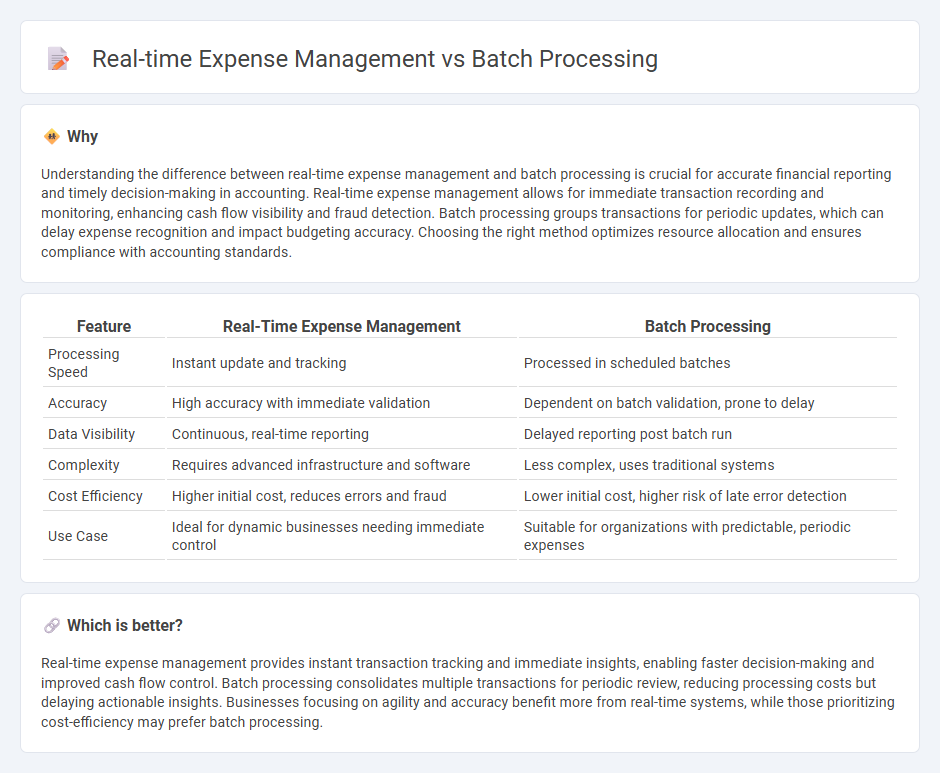
Real-time expense management enables immediate recording and analysis of financial transactions, enhancing accuracy and cash flow visibility compared to traditional batch processing, which consolidates data for periodic updates. This approach supports dynamic decision-making and reduces the risk of discrepancies by providing up-to-date expense information. Discover how real-time expense management can transform your accounting efficiency and accuracy.
Why it is important
Understanding the difference between real-time expense management and batch processing is crucial for accurate financial reporting and timely decision-making in accounting. Real-time expense management allows for immediate transaction recording and monitoring, enhancing cash flow visibility and fraud detection. Batch processing groups transactions for periodic updates, which can delay expense recognition and impact budgeting accuracy. Choosing the right method optimizes resource allocation and ensures compliance with accounting standards.
Comparison Table
| Feature | Real-Time Expense Management | Batch Processing |
|---|---|---|
| Processing Speed | Instant update and tracking | Processed in scheduled batches |
| Accuracy | High accuracy with immediate validation | Dependent on batch validation, prone to delay |
| Data Visibility | Continuous, real-time reporting | Delayed reporting post batch run |
| Complexity | Requires advanced infrastructure and software | Less complex, uses traditional systems |
| Cost Efficiency | Higher initial cost, reduces errors and fraud | Lower initial cost, higher risk of late error detection |
| Use Case | Ideal for dynamic businesses needing immediate control | Suitable for organizations with predictable, periodic expenses |
Which is better?
Real-time expense management provides instant transaction tracking and immediate insights, enabling faster decision-making and improved cash flow control. Batch processing consolidates multiple transactions for periodic review, reducing processing costs but delaying actionable insights. Businesses focusing on agility and accuracy benefit more from real-time systems, while those prioritizing cost-efficiency may prefer batch processing.
Connection
Real-time expense management streamlines financial tracking by instantly recording transactions, while batch processing consolidates multiple expense entries for efficient bulk handling and reconciliation. Implementing batch processing within real-time systems enhances data accuracy and reduces manual errors during expense audits. Combining these approaches optimizes accounting workflows, accelerates financial reporting, and improves overall expense control.
Key Terms
Transaction Timing
Batch processing in expense management involves collecting and processing transactions in scheduled intervals, often leading to delays between the expense occurrence and its recording. Real-time expense management captures and updates transactions immediately as they occur, enhancing accuracy and enabling instant financial insights. Discover how optimizing transaction timing can improve your expense management strategy.
Data Synchronization
Batch processing handles data synchronization by collecting and updating expense records at scheduled intervals, ensuring accuracy with some delay. Real-time expense management synchronizes data instantly, providing up-to-the-minute financial visibility and enabling immediate decision-making. Explore how each method impacts operational efficiency and data accuracy in expense management.
Expense Reporting
Batch processing in expense reporting consolidates transactions and processes them at scheduled intervals, improving efficiency for large volumes of expenses. Real-time expense management captures and records expenses immediately, enhancing accuracy and providing instant visibility into financial data. Explore the benefits and challenges of each method to optimize your expense reporting system.
Source and External Links
An Introduction to Batch Processing - Splunk - Batch processing is a computational technique where a large collection of data is gathered and then processed in a single operation, often scheduled and automated to handle large volumes efficiently, balancing between timeliness and thorough analysis.
What is Batch Processing? - AWS - Batch processing involves running high-volume, repetitive data jobs periodically by specifying job details such as batch size, input/output locations, and schedule, with dependencies managed to allow sequential or simultaneous execution of tasks.
Exploring Batch Processing: Definition, Use Cases, and Benefits - Batch processing is an automated method of processing grouped tasks without human intervention, ideal for large data volumes or repetitive tasks that do not require real-time processing, such as monthly credit card billing.
 dowidth.com
dowidth.com